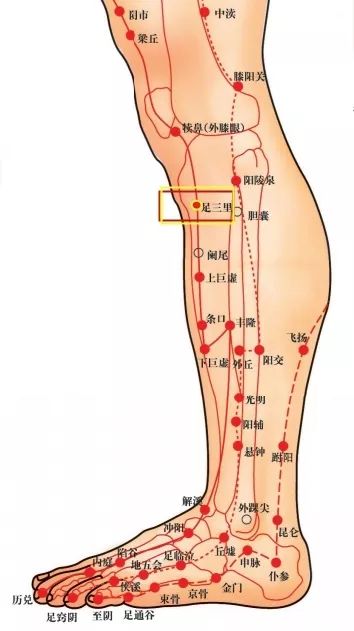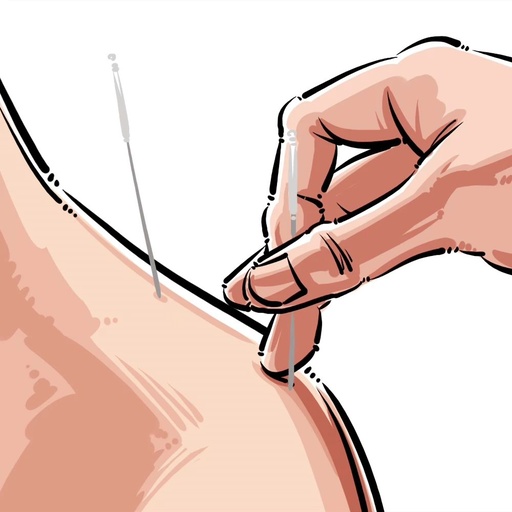Warm Reminder
This section aims to introduce the basic knowledge of acupoints in the human body, providing a fundamental understanding of them and a simple overview of their application in external therapies such as moxibustion, cupping, and guasha. Many acupoints have high risks associated with needling; non-professionals in acupuncture should not attempt needling operations!
Stomach Meridian of the Foot Yangming
🔹 Meridian Pathway
This meridian begins at the side of the nostril (Yingxiang point), ascends along the nose, intersects at the root of the nose, and enters the inner canthus of the eye, intersecting with the Foot Taiyang Meridian. It then descends along the lateral side of the nose, enters the upper teeth, exits, runs alongside the mouth, encircles the lips, intersects at the Chengjiang point in the mentolabial groove, and returns along the lower jawbone to the Daying point, ascending along the angle of the jaw, passing in front of the ear, and reaching the forehead.
A branch of this meridian descends from the Daying point to the Renying point, travels down the throat to the Dazhui point, bends forward, enters the diaphragm, belongs to the stomach, and connects to the spleen. A direct branch descends from the diaphragm, along the midline of the chest, runs alongside the navel (two inches lateral), and descends to the Qijie point in the groin. Another branch emerges from the pylorus of the stomach, descends within the abdominal cavity to the Qijie point, and then descends along the front of the thigh to the knee, following the anterior edge of the tibia down to the dorsum of the foot, entering the lateral side of the second toe (Lidui point). Another branch emerges from the Zusanli point (three inches below the knee) and descends to the lateral side of the middle toe. A further branch emerges from the Shangyang point on the dorsum of the foot, moving forward to the medial side of the big toe (Yinbai point), intersecting with the Foot Taiyin Spleen Meridian.

🔹 Indications Summary
This meridian’s acupoints are indicated for intestinal sounds, abdominal distension, abdominal pain, stomach pain, ascites, vomiting or excessive hunger, thirst, sore throat, epistaxis, pain in the chest and knee areas along the meridian pathway, febrile diseases, and mania.
Acupoints of the Stomach Meridian of the Foot Yangming
🔹 Zusanli (He point; Lower He point of the Stomach)
[Source] “Huangdi Neijing: Ling Shu”
[Location] Three inches below the Dubi point, one finger breadth lateral to the anterior crest of the tibia.
[Simple Acupoint Location Method] With the leg extended, use the thumb and index finger of the same side hand to encircle the outer edge of the patella, with the remaining four fingers pointing down; the tip of the middle finger is the point.

[Indications]
-
Stomach pain, vomiting, esophageal obstruction, abdominal distension, diarrhea, dysentery, constipation, and other gastrointestinal disorders;
-
Lower limb weakness;
-
Mania and other mental disorders;
-
Breast abscess, intestinal abscess, and other surgical conditions;
-
Various symptoms of deficiency, a key acupoint for health and strength.
[Applications]
The Zusanli point has the effects of generating stomach qi, drying dampness in the spleen, strengthening the spleen and stomach, supporting the body’s vital energy, promoting circulation, and regulating the ascending and descending of qi. It is indicated for gastrointestinal weakness, low gastrointestinal function, poor appetite, goiter, intestinal sounds, diarrhea, constipation, liver diseases, gastric spasms, acute and chronic gastritis, gastric prolapse, urinary tract infections, lower limb paralysis, hypertension, obesity, and halitosis. This point belongs to the Stomach Meridian of the Foot Yangming and has a wide range of treatment applications, including diseases of the circulatory, digestive, and respiratory systems, making it a primary acupoint for longevity and health maintenance.
Moxibustion Method:
-
Moxibustion on Zusanli, Pishu, Weishu, and Zhongwan can treat spleen and stomach deficiency and indigestion. Ignite the moxa stick and place it in a moxibustion box over the Pishu, Weishu, Zhongwan, and Zusanli points, adjusting the distance between the burning chamber and the skin to ensure the patient feels a comfortable temperature. Treatment duration is 30 minutes. Treat once daily, with a 5-day course followed by a 2-day interval, and observe the effects after 3 weeks.
-
Moxibustion on Zusanli, Guanyuan, Zhongwan, and Fenglong points can dispel dampness and aid in weight loss. Each acupoint is moxibusted for 20 minutes, once daily, with a rest day after one week of treatment.
Cupping Method:
-
Cupping on Tianshu, Guanyuan, Zusanli, and Shangjuxu can treat constipation. Use simple cupping, leaving the cup for 10 minutes; if it is a case of deficiency-cold constipation, add moxibustion after cupping; treat once daily.
-
Cupping on Pishu, Sanjiao, Zhongwan, Daheng, and Zusanli can regulate spleen and stomach deficiency and eliminate phlegm-dampness for weight loss. Use appropriately sized glass cups, applying the flash fire method for cupping, and attach them to the aforementioned acupoints. Cupping can also be performed on the waist and thigh areas where muscle is abundant, leaving the cups for 15 minutes, every other day, with 10 sessions as one course. Women should stop during menstruation. Observe treatment effects after two courses.
Guasha Method: Use the scraping method on the Zusanli point until a reddish heat appears, which can treat vomiting, abdominal distension, intestinal sounds, and indigestion.
Health Massage: Press the Zusanli point with the thumb or index finger for 5-10 minutes daily, with 15-20 presses per minute. Long-term adherence can invigorate energy and promote longevity.
[Literature]
“Ling Shu”: If evil resides in the spleen and stomach, it causes muscle pain; if yang qi is excessive and yin qi is deficient, it leads to heat and excessive hunger; if yang qi is deficient and yin qi is excessive, it results in cold, intestinal sounds, and abdominal pain. If both yin and yang are excessive or deficient, there will be both cold and heat. All can be regulated at Zusanli.
“Ling Shu”: If the obstruction does not go away, and the cold persists, one should take the three li bones as a remedy. If there is constipation, take the three li… If there is good vomiting, with bitter vomit, long sighs, and fear of being caught, the evil is in the gallbladder, reversing in the stomach; if the gallbladder fluid leaks, it causes a bitter mouth, and if the stomach qi reverses, it causes bitter vomiting, hence it is called gallbladder vomiting, take the three li to reverse the stomach qi.
“Wai Tai”: For individuals over thirty years old, if they do not moxibustion on the three li, it causes qi to rise and the eyes to darken; thus, moxibustion on the three li lowers qi.
“Four Total Points”: The three li in the abdomen should be retained.
“Tong Xuan Zhi Yao Fu”: The three li dispel the five labors of weakness; if the kidney is obstructed, take from the upper part of the Foot Yangming.
“Yu Long Fu”: For palpitations and restlessness, needle the three li.
*Acupoint images are from the illustrated “Huangdi Neijing” published by Zitu Books
Cover | Eight Years Old
Editor | Yun Shao

